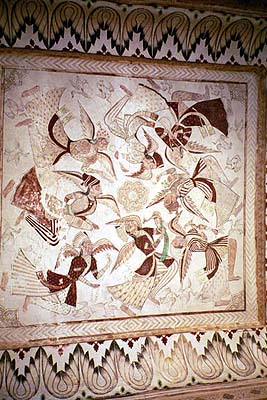Art
Rajasthan’s role in the development of Indian art has been very important. The decoration of dwellings and other household objects was but one aspect of the creative genius of the Rajasthani — the world of miniature paintings is perhaps the most fascinating and the distinctive styles that have existed here are renowned the world over. From the 16th century onwards there flourished different schools of paintings like the Mewar school, the Bundi-Kota kalam, the Jaipur, Bikaner, Kishengarh and Mewar schools.
Influenced by the surroundings, these medieval paintings have their own unique styles — the hills and valleys, deserts, palaces and forts, gardens, court scenes, religious processions and those highlighting scenes from the life of Lord Krishna were the recurrent themes of these paintings. The Raagamala paintings and those based on Geeta Govinda are treasures of Rajasthan. It is widely believed that the miniature artists of Rajasthan were practising and perfecting their art as early as the begining of the 16th century and were later employed by the Mughal courts, specially by the Great Mughal emperor Akbar.


The colors used by the miniature artists were made from minerals, vegetables, precious stones, indigo, conch shells, pure gold and silver. The preparing and mixing of colour was an elaborate process and it took weeks, sometimes months, to get the desired results. Very fine, specially created brushes were made for different kinds of paintings.
The landscape changed, the colours used were varied, paintings were done on paper and palm leaf to illustrate manuscripts. On walls of palaces and the inner chambers of forts and havelies trecoes were made. The painted havelies of Shekhawati are well-known for it. But the importance of miniatures has never diminished — even after all these years. Paintings influenced by Mughal court provide an interesting insight into the lifestyle of the centuries and continue to fascinate the scholars to this day. Artists in Jaipur, Nathdwara and Kishengarh still work on miniatures and some of them produce excellent work. The magical quality of the miniature continuous to live on.
painting 2
In a different class but with several similarities are the cloth paintings of Rajasthan which include the phads — scroll paintings used by the Bhopas and the pichwais — cloth
hangings used behind the deity in Vaishnava temples. Done in bright colours with bold outlines, these paintings have very strong religious traditions. And the artist who works on them considers himself to be a servant of the Lord and puts in shraddha or devotion on each pichwai or phad that he paints. This art form is also done for commercial use.
